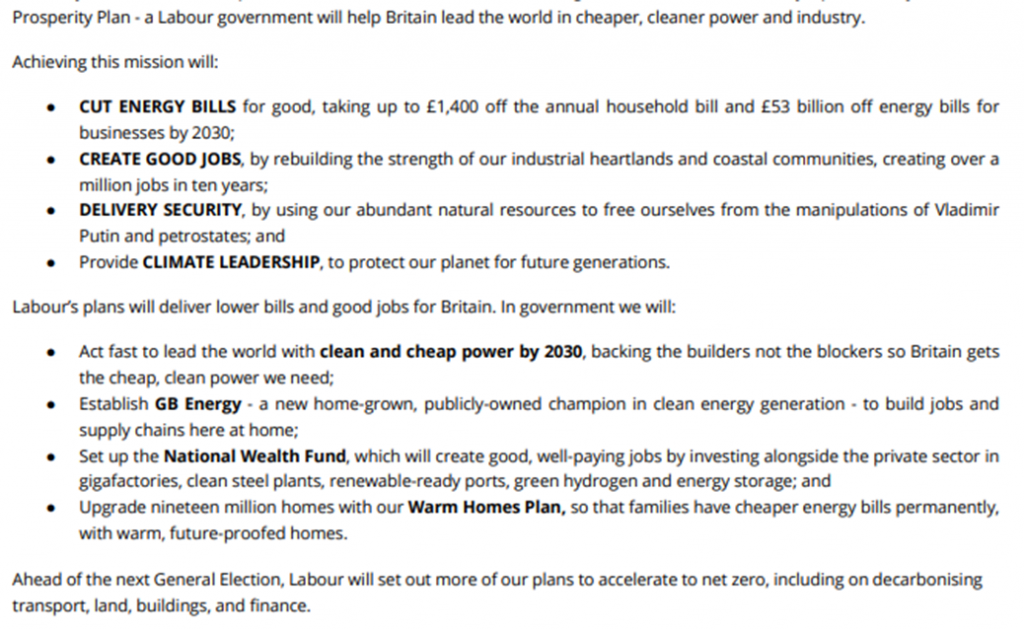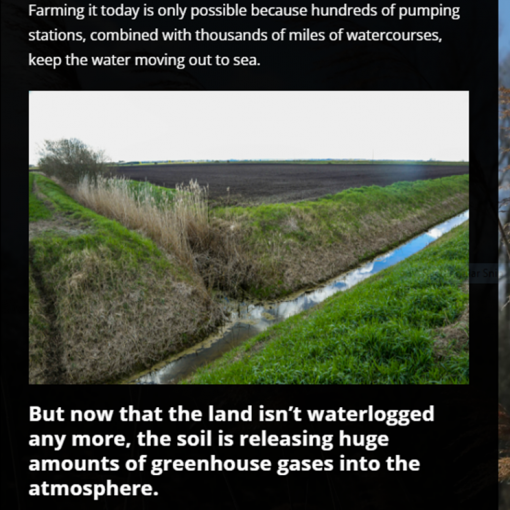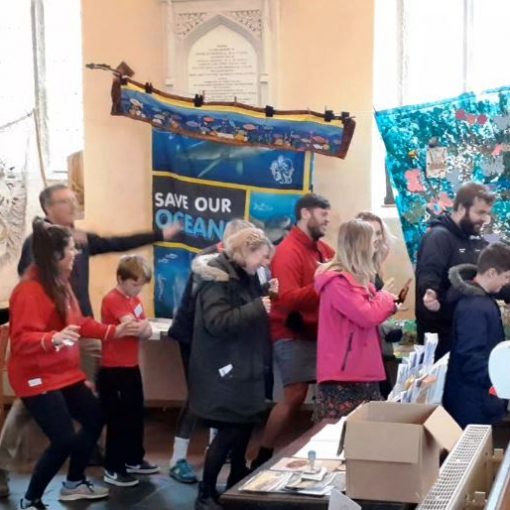20th October
The importance of keeping promises – consideration of Climate Pledges in advance of COP 28. Then quite a bit about food and some new considerations about water.


One of my priorities, as someone who is looking for truth to share with readers, is to make sure I tell you when something proves to be inaccurate or wrong. I discovered one this morning on a very early visit to the beach. If you read Blog week 31 you might remember the story of ‘Time and Tide Bell’. There is now a board on display, that tells us The chimes ring out … to celebrate the connection of land and sea and it tolls a warning of rising seas and climate change. I know a lot of time and effort went into this project, plus of course substantial funding, so someone really should be answering the question ‘why is there no bell ringing?’ Personally, I think I prefer it quiet, but this has raised us a topic to think about – ‘why do people fail to deliver on promises and what is the result?’
In my weekly nod to the news, I continue to hold my breath over the precarious situation in Gaza, but with a little relief that President Biden called for humanitarian aid to go in. Calling for something is easy, making it happen is so much more challenging. When, at around the time of Cop 26, Boris was pledging the UK would outlaw petrol and diesel cars by 2030 he had no way of seeing into the future and surely did not expect Rishi, or his U Turn to follow. But if Rishi was in any doubt over the effect of breaking a big promise or 2, he had a powerful lesson after the by elections last week!


I hope you can read the pictures, which show the scale of defeats in Tamworth and Mid Beds. These have initially been attributed to Boris’s Partygate and Liz Truss’s economic fiasco, but isn’t it very possible that voters really do want a commitment to sorting out our energy systems? It is not my place to promote green policies of either party, but it does appear to me that this document is worthy of some attention before we all have to cast our votes next year.
https://labour.org.uk/wp-content/uploads/2023/06/Mission-Climate.pdf from which I selected the section of their 4 key aims, followed by the promises. What do you make of them and will they prove to be another set of empty words, never to be fulfilled?
Promise or pledge? A pledge is just a promise with more emphasis on it.
My most pressing task in the next couple of days is to formulate the pledges for our Half Term Ceremony next week. I don’t really remember where I got the word pledge from, when planning the first Ceremony, so am giving myself a moment to consider ‘is it the right word?’
The quote above is not a dictionary definition, but I like it. The emphasis hopefully translates into very strong commitment, with a sense of realism. In the first Ceremony I was able to share an invaluable practical page from Luci Isaacson of Climate Vision. I believe she is in the process of making some place mats with this on; the key thing is to provide that sense of what is easy to grasp and practical to deliver. (PS is it just me, or do you react with a strong dislike of the font here?)

Our version of pledges
Now let’s look at the way we will use words in the Ceremony at Half Term. Some key points will be:-
- Start from gratitude – a positive mood and hope e.g. Come ye Thankful People come!
- Incorporate a Haiku message
- End with the actual pledge
As we will be working together every day, Monday to Friday, there will be 5 sections.
ON MONDAY
Participants will get a double-sided worksheet all about history of farming, chemistry and cooking with apples.
The first page thanks will be for plants and trees, that give us air to breathe, food to eat and medicines to heal. Then a Haiku. And ending with Pledge 1) We pledge to know and nurture places where special plants grow, such as rainforests even here in Cornwall as well as around the world, along with moorlands, wetlands and seagrass off our coast. The second page has a focus on Apples and refers to Apple Day – on this very day 21st October

I wonder how to create a promise or two, linked with this text? There will be gratitude, for the many high-quality makers of juices and ciders, distillers and brewers in this part of Cornwall.
Then the Apple Tree Haiku leading into
Pledge 2) We pledge to support those who make delicious drinks from our local sources of fruits and grains (soft & alcoholic!); and we will seek out Apple Day activities to join, each year.
ON TUESDAY
The worksheet covers threats to our bees and other pollinators, great uses for bees’ wax (https://beeswaxco.com/bulk-beeswax/the-history-of-human-uses-for-beeswax/) and baking with honey and seeds. The 2nd side is about birds and their importance for plants – many plant species rely almost entirely on birds for their propagation.
We are grateful to the visiting bee keeper, and all of Cornwall Association of Bee Keepers. Also to RSPB, for its work protecting birds in our area. There are Haikus for both.
1st) We pledge to campaign against harmful pesticides, especially emergency permissions for neonics, that can kill billions of bees to benefit big sugar beet business owners.
2nd) We pledge to press for all chickens to be reared in a healthy outdoor environment, not factories. And where the chance arises, we will protect nests of wild birds and provide food and water.


But it is a tribute to the little one that frequently bobs around on the patio here, the spirit of my Mum I think!
ON WEDNESDAY
This is a worksheet about walking by a river and testing water quality. The route planned is from the centre of Lostwithiel town to the Shire Hall nature reserve. Plans have only come together in the past week, for which I am so grateful to the Westcountry Rivers Trust and their local CSI volunteer, Anna. CSI stands for Citizen Scientist Investigations and the first page tells us …
The aims of Citizen Scientist Investigations are:
- To educate and engage people with the water environment.
- To produce data that can be used to target work and identify degrading water bodies.
- To spot pollution events which can be dealt with as quickly as possible.
- To create a network of catchment communities that are invested in their local environment. ARE WE INVESTED?
Anna has been successful in borrowing extra kit, so we can show participants how to use the nitrate testing kit and flow meter. Also, we are allowed to use some of the Rivers Trust phosphate strips, so the people attending will really be able to have a proper go if they want.
I did a test walk today, which raised a few questions. At this time of year there is a great mass of fallen leaves in the water; looking this up, it is not entirely a good thing. More organic matter decomposing can offer beneficial nourishment for ’aquatic ecosystems’. But equally too much adds to the nutrient problems and potentially ‘harmful algal blooms’ (HABs) as a result.
A little further along I spied massed high bull rushes and waving reeds. These are very good news, on all levels. They help to stabilise banks and protect from erosion, they provide great habitats for wildlife and act as natural filters, removing pollutants and oxygenating the water.
My third query was ‘what is that bird that looks like a white heron?’ Fortunately, I arrived at a sign which gave the answer. It was an egret, and possibly – according to Anna – a great white egret, previously a very rare sight but increasingly can be seen in more locations throughout the year.

At the moment, this Welly Walk activity seems likely to attract mainly adults so my preference is to wait and involve whoever comes on the walk, asking them is there anything we are grateful for? And can they help arrive at pledges, hopefully something a little different, rather than simply copying Fergal Sharkey or Surfers against Sewage. However, I would like to see if we can reference a great success – Namibia
Namibia is the driest country in Sub-Saharan Africa, and home to two of the world’s most ancient deserts, the Kalahari and the Namib. The capital, Windhoek, is sandwiched between them, 400 miles away from the nearest perennial river and more than 300 miles away from the coast. Water is in short supply.
It’s hard to imagine life thriving in Windhoek, yet 477,000 people call it home, and 99 per cent of them have access to drinking water thanks to technology pioneered 55 years ago on the outskirts of the city. Now, some of the world’s biggest cities are embracing this technology as they adapt to the harshest impacts of climate change. But Namibia leads the way.
How did this come about? In the 1950s, Windhoek’s natural resources struggled to cope with a rapidly growing population, and severe water shortages gripped the city. But disaster forced innovation, and in 1968 the Goreangab Water Reclamation Plant in Windhoek became the first place in the world to produce drinking water directly from sewage, a process known as Direct Potable Reuse (DPR). https://www.positive.news/society/namibia-circular-water-system/
Maybe SW Water should be setting up this DPR method, rather than desalination? But – as the article says – Disgust is a powerful emotion, and sensationalist ‘toilet to tap’ headlines have dismantled support for water reuse projects in the past. Unfortunately, DPR’s biggest strength is also its biggest weakness, as the speed at which water can re-enter the system makes it especially vulnerable to prejudice, causing regulators to hesitate.
ON THURSDAY
We have had a last-minute switch of topics here, as the Community Café folks opted to reject sausages and roasted root vegs, in favour of a hearty Autumn Beef Stew. Now I confess, in this holiday scheme, I never wanted to engage with the questions about ‘should we eat meat or all go vegan?’ Never mind, it is important and I have very good assistance in the form of a film from Cornwall Climate Care – ‘Food for Thought’ (thank you ladies, for permission to use this). If you can spare a bit of time, I very much recommend watching the main contributors, Lisa, who farms in West Cornwall, Becky Wilson who created a ‘Farm Carbon-measurement Toolkit’, and Robin Jackson, from Future Farm at Duchy College. As the blurb tells us, it really is complicated to balance and achieve the right answer ‘should we all give up meat and dairy?’ Saying yes would be too simplistic an answer – and what would it mean for Cornwall, where the majority of farmland is used to raise livestock or to grow crops for these animals to eat?
https://www.cornwallclimate.org/films and specifically https://www.cornwallclimate.org/films/food-for-thought
also find this one directly, on Youtube https://www.youtube.com/watch?v=aeHWhuI8ng8
I stuck with my research on this, for a while longer, to look at the origins of the beef that will make the stew. It comes via one of the most respected and highly valued farm sources – JV Richards – as described by another popular local butcher under the heading: –
TRACEABILITY
There are many ways we can give our customers good service. There are fewer ways of customer confidence. That’s why we take seriously our constant weekly updates of ” Farm Traceability “. Our customers, now, more than ever, expect to know the source of the meats they feed their families with.
We are very grateful for the support we receive from our local abattoir (J. V. Richards Ltd) who regularly provide us with information to pass on to our customers. We receive various valid questions on various dietary requirements on whatever meats.
To be able to answer these can only improve us as a business, to continually strive to give our customers an enjoyable shopping experience with that bonus of “customer confidence” in “Kittow’s Quality Meats” of St . Austell.
THIS MONTHS FARMS:
- J V Richards, Rietfontein, Perranwell Station, Bisoe, Truro, Cornwall
- Mr Richards, Trendeal, Summercourt, Newquay, Cornwall
- Mr Rapson, Carneborne, Helston, Cornwall
- Gay – Lanner, Barton, St Allen, Truro, Cornwall
With all this buzzing in my head, how can I progress towards meaningful pledges about best farming practices and meat production? We are grateful for all farmers and growers who adopt organic, regenerative and re-wilding practices (PS have you seen that M & S advert on TV, referring to regenerative methods? It ties in with this policy corporate.marksandspencer.com/producing-delicious-ms-quality-products-nature-friendly-ways-three-years-ms-leading-farming-nature)


The 1st image from ‘Food for Thought’ webpage could provide something for Pledge 1) We pledge to be thoughtful and responsible sourcing our food, and – so far as finances allow – will always do our best to support local growers & the ‘Real Food’ movement.
And the 2nd picture, which is part of the soil worksheet, suggests our other Thursday pledge could start with the mining topic. We are grateful for the riches of minerals and rocks beneath our feet. But … Haiku needed, and a pledge, which will be a tricky one! Send suggestions please.
Mining Gumboots around the world
It was a recent press release that told me about the Nevada situation, which is so relevant and parallel with Cornwall. Apparently, the Native American Indians are divided and cannot reach a common approach, but I can’t find where I read that. Some want the money and the work but most reports I can find are saying the tribes are opposed:-
The conflict starkly illustrates the trade-offs involved in tackling climate change in a business-as-usual way. According to the International Energy Agency, demand for lithium could rise forty-fold by 2040 if the world rapidly embraces electric vehicles, which use lithium-ion batteries. Over its 41-year projected lifespan, Lithium Nevada expects the Thacker Pass mine to generate up to 80,000 tons of lithium carbonate a year — equal to roughly a fifth of global lithium production in 2020. But Native opponents on the front lines of mining say that the price of that lithium is too high.
“Annihilating old growth sagebrush, Indigenous peoples’ medicines, food, and ceremonial grounds for electric vehicles isn’t very climate conscious,” said Arlan Melendez, the chair of the Reno-Sparks Indian Colony, a tribe in Nevada whose members have cultural ties to Thacker Pass.
https://grist.org/protest/native-opposition-to-nevada-lithium-mine-grows/
also try this one for data on water use and contamination (in the week when Cornwall’s South Crofty mine announced its new plant for remediating contaminated mine water, it should make us aware that remediation is not the only concern) – The Thacker Pass lithium project is expected to use 1.7bn gallons of water annually to produce 60,000 metric tons of lithium carbonate a year. https://www.theguardian.com/us-news/2023/oct/13/native-americans-1865-massacre-lithium-mine-thacker-pass
ON FRIDAY
I am exhausted just writing this and thinking, will I make it to the final day? The big Ceremony? Of course I will. What should the final words be? First, gratitude for shops, restaurants and chefs. Everyone who makes that vital link between Farm and Fork. I am especially delighted to be supported by small shops in Lostwithiel and our local Co-op, who did not tell me of their own education work. I shall be questioning further, for sure!

And last, but not least, thanks to all who have helped with making the Half Term events and Ceremony happen (successfully? Fingers crossed!). I think the Pledge will be to continue developing Half Terms 4 Climate Hope and working to strengthen such activities in many more communities round the world.
IMPORTANT POST SCRIPT
NB please be respectful of my copyright and do not offer these images and words for use by other people or organisations. Instead, ask them to contact me to arrange their own official copies. Thank you.




